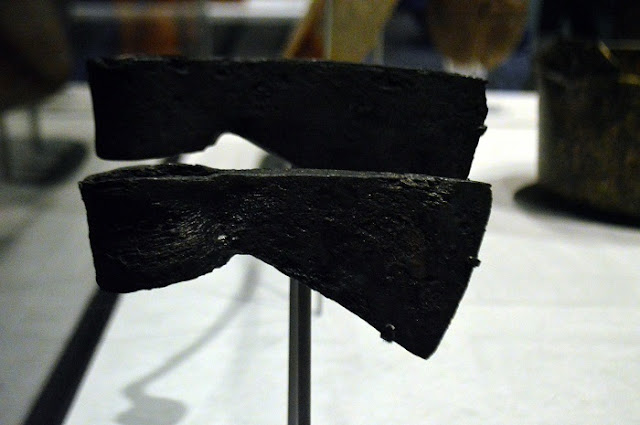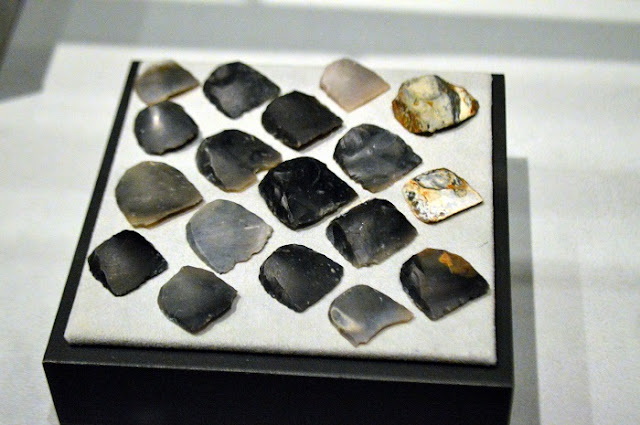The Wreck of La Belle and the archaeology of French Texas
Last November I had the good fortune to be in Austin, TX. Although I was there in my guise of IT guy to attend the Tableau conference, I had a little free time to myself got the opportunity to visit The Bullock Texas State History Museum. Should you get the chance, I would heartily recommend a visit. For those who can’t make it (or need some encouragement to go) I offer this brief collection of posts, showcasing some of the exhibits. To my mind, the premier exhibit in this fascinating museum is La Belle: The Ship That Changed History.
The story started in 1684, when Louis XIV sent Robert Cavelier de la Salle off with four ships and 400 people. The plan was to head to North America and establish a colony at the mouth of the Mississippi. The new colony would become the focus of lucrative trade routes and everyone would get rich … very rich! Well … that was the plan … and things didn’t quite go to plan. To be fair, I’m rather stretching the meaning of the phrase ‘didn’t quite go to plan’ here. Poor Robert accidentally sailed past his destination, lost ships to mishaps and marauders, and was eventually murdered by his own crew … as I say, not quite to plan! In 1686, La Belle, was wrecked in a storm and sank into the mud of Matagorda Bay. What was a disaster in 1686 proved to be a remarkable discovery in 1995 when the ship was located by archaeologists. The lengthy ensuing excavation allowed the recovery of 1.6 million artefacts, along with a sizeable portion of the ship’s hull. The museum provides a wonderful website with some beautiful photography that I urge you to visit (here). From a European perspective, this is a fantastic survival of post-Medieval French maritime history that also provides insights into trade practices and social conditions of the period … it just happens to be located on the other side of the planet …
The Ship
La Belle was a three-masted ship that measured approximately 54ft in
length, 15ft wide, had a 7ft draft, and carried around 35 people. It was
designed for navigating shallow coastal waters as well as sailing up rivers as
part of De la Salle’s programme of exploration. Interestingly, La Belle was never intended to sail
across the Atlantic. Instead, she was supposed to have been packed up in the
belly of Le Joly, another of his ships, for assembly in the
New World. As it turned out, the other ships were already too full with other
supplies and La Belle was constructed
at Rocheford, in France. As it was a ‘kit ship’, the main timbers were each
carved with a combination of letters and Roman numerals to match so it could be
reassembled in the correct way. I was particularly taken with the system used –
the central reference point was the mainmast and ribs forward of this were
numbered IA-XIIA (Avant) while the ribs behind were labelled ID-XVIID (Devant).
Obviously, the lower portion of the hull and side of the ship have survived well, but items of rigging have also been found. The three-holed wooden artefact on the left (above) is a deadeye ‘block’ or pulley used in the adjustment of the ship’s sails. The example on the right is a fiddle block variant. Owing to constant use and wear, these pieces were usually made of durable hardwoods, such as oak or lignum vitae.
This is a single block,
the simplest form of block pulley used on board ship.
This 1:12 scale model
of La Belle gives a clear indication of what it would have looked like when new
and is cut away to reveal the layout of the internal compartments and their
contents, based on surviving documents and the archaeological evidence.
Items for daily life in
the Colony
One of the points that
the exhibit makes very well is that while the individual artefacts all have
important and interesting stories, it is the totality of the finds that give us
insights into what Europeans thought was necessary to create a sustainable
colony in North America. This collection included necessities such as cooking
pots, plates, bowls, a surgical kit, a collection of carpentry tools, along
with unworked iron to make nails and other necessities.
This collection of
brass cooking pots and a colander was found nested inside each other, along
with a ladle and a pair of candlesticks. They had been stowed in the ship's hold inside
a large chest.
Even in the New World
the necessity of grinding grain to make bread remained the same as at home.
This rotary quern will be familiar to archaeologists on this side of the
Atlantic. For anyone not familiar with the artefact, a upper stone is turned by
hand against a stationary lower stone and the grain is ground to flour in
action between the two. As this example has no central perforation to introduce
grain into the mechanism or a partial hole near the edge to facilitate a wooden
handle, I presume that it’s the lower stone.
The excavation found
four barrels of axe heads, but no axe handles. The assumption is that the
colonists would have made handles once they landed and then used them to create
houses and a defensive compound. They would also have been prized trade items, used for exchange with the indigenous population.
La Belle contained a large collection of combs, many of which were
probably intended as trade goods. However, this pair of combs preserved together
in a wallet were most likely the personal property of a sailor or colonist. In
particular, the fine comb on the left is thought to have been for checking for
lice.
As well as the stamped
decoration on the handle, this shallow bowl or porringer has the name ‘C.
Barange’ inscribed on its side, possibly the name of one of the sailors.
Trade items
While some artefacts
may be seen both as useful to the colonists and as trade items, much of La
Belle’s cargo, and that of the other ships in his fleet, would have been
intended only for trade. The largest portion of these trade goods would have
been glass beads, but they also brought bells, knives, finger rings, mirrors,
combs, and vermilion dye. De la Salle traded these for food, horses, guides, along
with furs and hides that he intended to send back to France.
During an earlier mission through Canada, De la Salle learned that the Native population liked and valued
glass beads, so he ensured that his expedition to the Mississippi carried them
in their hundreds of thousands.
Over 500 knives were
recovered during the excavation, many of which were intended for trade
purposes. These included straight knives, carefully wrapped in paper, and
folding-clasp knives.
On the left is a sample
of the 1600 brass hawk bells recovered during the course of the excavation.
While designed to be worn by trained birds of prey in Europe, they were traded
to the Native population to be sewn on to clothing. On the right is a selection
of the 1603 brass finger rings, also for trading, recovered from the wreck.
These are known as ‘Jesuit rings’ owing to their religious iconography.
Attack and defence
De la Salle and his
colonists knew that they were going to an environment that was hostile to them,
so the expedition was well stocked with weapons. Bronze and iron cannon were
carried in the hold of the La Belle.
These were intended to protect the fledgling colony, while a number of deck
cannon and swivel guns protected the ship. Smaller weapons (for both hunting
and defence) included two different types of firearms, supplied with a number
of different forms of shot and ammunition. As the industrial capabilities
necessary to produce projectiles and powder did not exist where they were
going, and could not be independently manufactured by the colonists, they
brought as much as they could with them. It is interesting to reflect that of
the 86 barrels retrieved during the excavation, 33 contained shot, while a
further 16 were filled with gunpowder.
On the left is a brass
powder flask for pouring measured amounts of gunpowder into a firearm. To the
right are a selection of three surviving gunpowder cartridges, each originally
holding a pre-measured charge of gunpowder.
The guns on board were
flintlocks, which required a gunflint as part of the mechanism to create a
spark and expel the projectile. This image shows a collection of rather lovely
examples. Even after all these years in archaeology, it still strikes me as so
strange, seeing this most quintessential of prehistoric technologies still used
until (relatively) recently. I put it down to having spent too long among the prehistorians.
Two of the flintlock
muskets recovered from the wreck.
This firepot is a
remarkable survival, not simply that the ceramic vessel is intact, but
that the wooden lid and fuse holder are also preserved. If this example had
been used, a grenade would have been placed inside the pot with the fuse
sticking out of the top. When thrown, the pot and grenade would have exploded upon impact.
The colony at Fort Saint
Louis faced difficulties from the outset and by 1688 La Salle and most of the
settlers were dead and the settlement was in ruins. The remains of the site were
discovered by the Spanish officer Alonso de León the following year. De León
ordered the burial of the cannon and burnt the surviving buildings. Eventually the
location of Fort Saint Louis was lost and the eight iron cannon (one pictured
above) that defended the settlement remained buried until accidentally discovered
by a ranch foreman in 1996.
This is one of three
bronze cannon found in the hull of La
Belle. All three have dolphin-shaped lifting handles and bear the crest of
the Admiral of the French Navy.
In a lot of my posts I
add the suggestion that if you like my writing, I’d be grateful for a donation.
Nothing too extravagant – just the price of a pint or a coffee (but I’ll
probably just spend it on books). In this case, I’d also add that if you were so
inclined, you could consider throwing a few of whatever your local currency is in
the direction of the museum: here.























Comments
Post a Comment